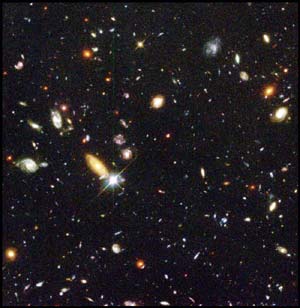 Deep image from the Hubble Space Telescope
Deep image from the Hubble Space Telescope
known as the Hubble Deep Field.
A few bright round objects, i.e. the bright white object
left of center, are stars. All other objects are galaxies,
some as far as 12 billion light years away.To be perfectly honest, although my last posting focused on stars and extrasolar planets, as a cosmologist I find these to be quite mundane. On the one hand, Venus does seem impossibly far away when you think about how long it takes to fly smushed in coach class all the way to Rio de Janeiro. On these scales, Pluto, sitting out near the edge of our solar system, seems to be the edge of time and space. On the other hand, if you want to go out and study the universe, our solar system doesn’t even register as a tick on your yardstick.
To continue with this complex analogy, I’d say the first ticks on your yardstick are galaxies like our very own Milky Way. All of those extrasolar planets I talked about before have been discovered in our very small, local neighborhood of the Milky Way.
The Milky Way is only one of the many galaxies in the universe. There are so many that Bill Gates wouldn’t be able to buy all of them if the universe were holding a liquidation sale, even at the bargain price of $1.00 each. If you want to find extrasolar planets in other galaxies, forget about it. Individual stars are extremely difficult to observe outside of the Milky Way, not to mention the planets around those stars.
From the Land Down Under, I am intrigued by university lecturer Glen Mackie, who took the time to estimate the total number of galaxies in the universe, and the stars in those galaxies. He compares the total number of stars in the universe to the total number of grains of sand on Earth and finds the sand is outscored by 20 to 1. It is quite humbling to think that the Sun, which is central to our very existence, is as unique to the universe as a single grain of sand is unique to our Earth. There are many other such analogies - let me know some of your favorites in a response to this post.
With such a large number of galaxies in the universe, there’s a lot that we don’t yet understand. One project working to gain some insight into the various populations of galaxies is the DEEP survey. They are using the Keck Observatory, found in one of my favorite destinations, the Big Island of Hawaii. Hawaii is not only a great place for snorkeling and SPAM, but also a phenomenal place to observe very distant galaxies.
